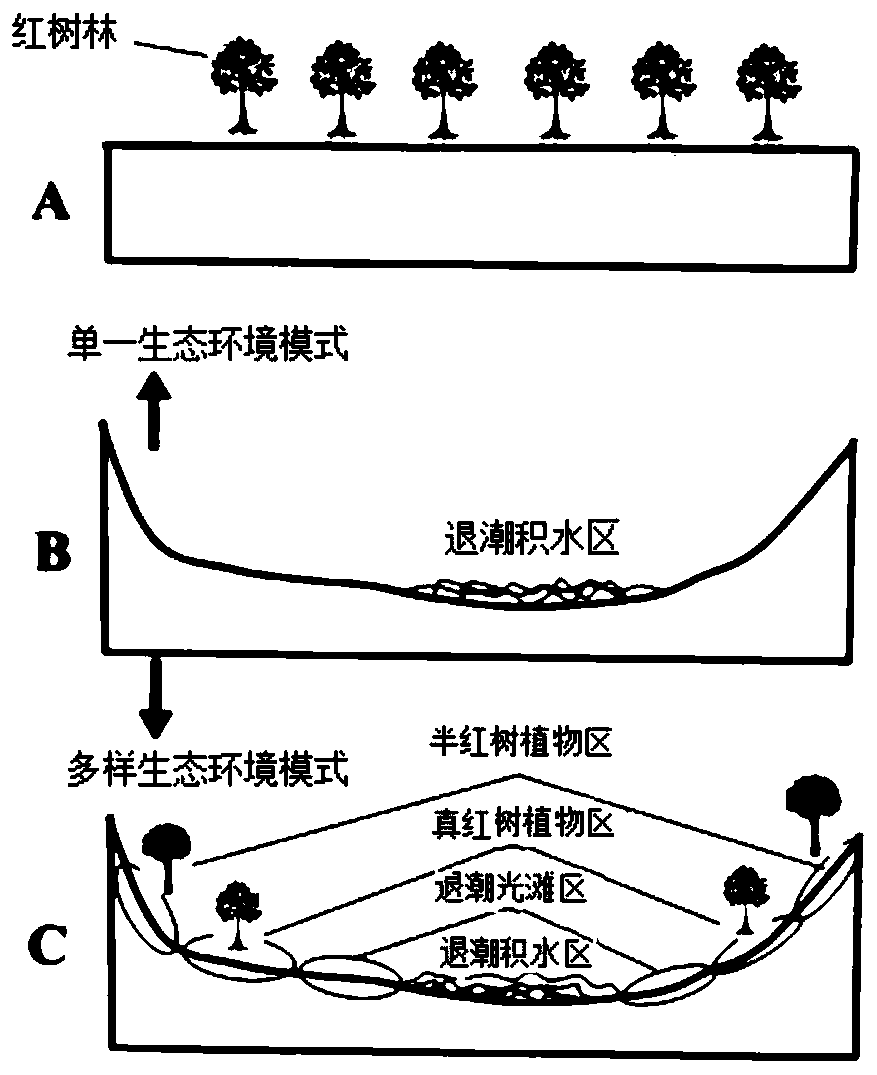Method for returning ponds for recovery of forests and wetlands
A technology of fish ponds and pioneer tree species, applied in cultivation, agriculture, application, etc., can solve the problems of low survival rate of afforestation and low biodiversity
- Summary
- Abstract
- Description
- Claims
- Application Information
AI Technical Summary
Problems solved by technology
Method used
Image
Examples
Embodiment approach
[0010] According to a preferred embodiment of the present invention, when the bottom elevation of the fish pond is above the mean sea level and not higher than the spring tide high tide line, then the whole fish pond is planted with mangrove seedlings; when the bottom of the fish pond When the elevation is below the mean sea level, then the said fish pond does not plant any plants at the elevation below the mean sea level, and mangrove plant seedlings are only planted on the embankment edge and embankment of the fish pond above the mean sea level, so that except when the tide is low In addition to the stagnant water area, a part of bare tidal flats can be reserved around the water stagnant area to create space for birds to forage and benthic animals to inhabit.
[0011] In the present invention, the middle and low tide zone is dominated by pioneer tree species means that the proportion of pioneer tree species is more than 90%, preferably more than 95%, more preferably 100%. Th...
Embodiment 1
[0017] This embodiment is used to illustrate the method for returning ponds to forests and returning wetness provided by the present invention.
[0018] Choose a fish pond whose bottom elevation is lower than the average sea level (less than 10 acres), and open two gaps with a width of 3 meters near the ditch to drain the water in the fish pond. The depth of the gap in the fish pond is such that the ebb tide At this time, the bottom of the fish pond should retain a part of the accumulated water area to facilitate fish habitat and birds foraging.
[0019] Next, mangrove seedlings are artificially planted. The tree species configuration mode is determined according to the elevation, and no mangrove seedlings are planted in the part below the mean sea level. Plant cotyledon bag seedlings in the mid-low tide zone (planting density is 800 plants / mu), plant candiba hypocotyls or bag seedlings in the mid-tidal zone (the depth of the candela hypocotyl is 1 / 3 of the total length of the...
Embodiment 2
[0022] This embodiment is used to illustrate the method for returning ponds to forests and returning wetness provided by the present invention.
[0023] Choose a fish pond whose bottom elevation is higher than the mean sea level but lower than the high tide line, and open two gaps with a width of 3 meters near the ditch to discharge the water in the fish pond, and the depth of the gap in the fish pond is such that the ebb tide When there is no water at the bottom of the fish pond.
[0024] Then mangrove seedlings are artificially planted, the tree species configuration mode is determined according to the elevation, and mangrove seedlings are planted in the whole fish pond. Plant tung tree bag seedlings in the mid-low tide zone (planting density is 667 plants / mu), plant red sea olive bag seedlings (planting density is 667 plants / mu) in the mid-tidal zone, and plant sea lotus bag seedlings in the high tide zone (planting density is 667 plants / mu) mu), and the embankment of fish...
PUM
 Login to View More
Login to View More Abstract
Description
Claims
Application Information
 Login to View More
Login to View More - R&D
- Intellectual Property
- Life Sciences
- Materials
- Tech Scout
- Unparalleled Data Quality
- Higher Quality Content
- 60% Fewer Hallucinations
Browse by: Latest US Patents, China's latest patents, Technical Efficacy Thesaurus, Application Domain, Technology Topic, Popular Technical Reports.
© 2025 PatSnap. All rights reserved.Legal|Privacy policy|Modern Slavery Act Transparency Statement|Sitemap|About US| Contact US: help@patsnap.com

